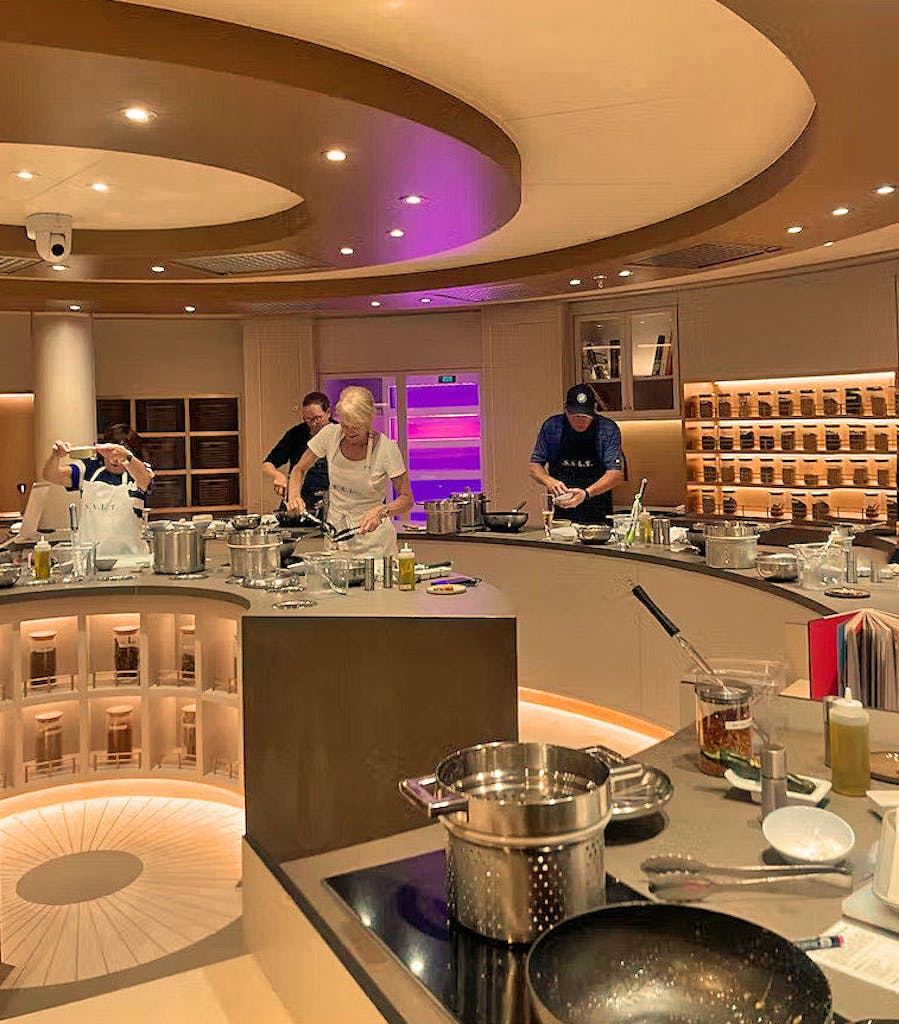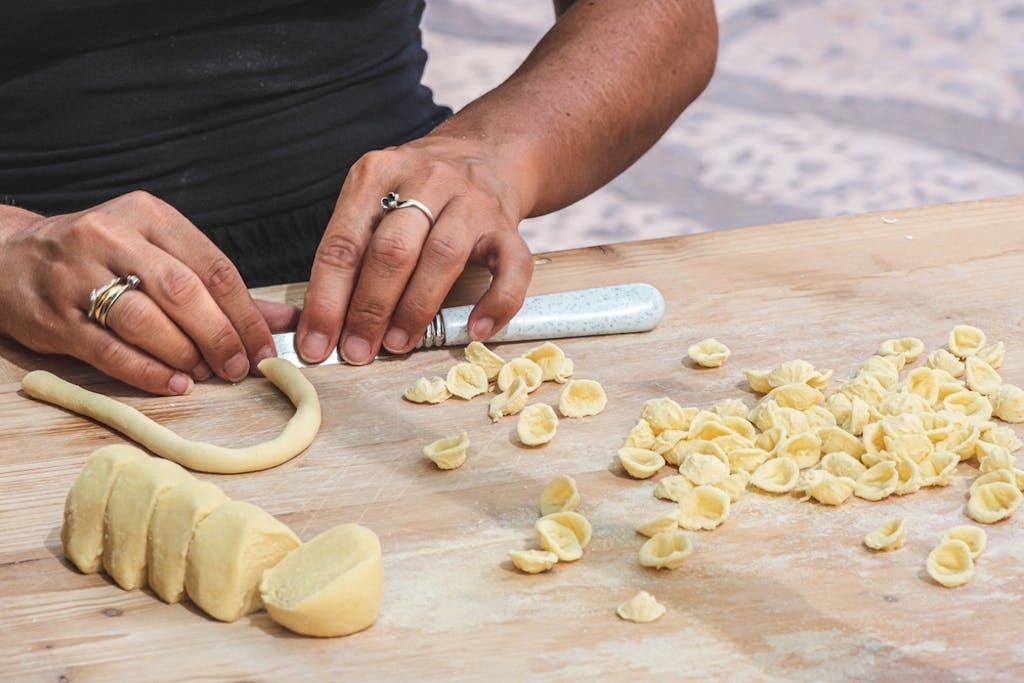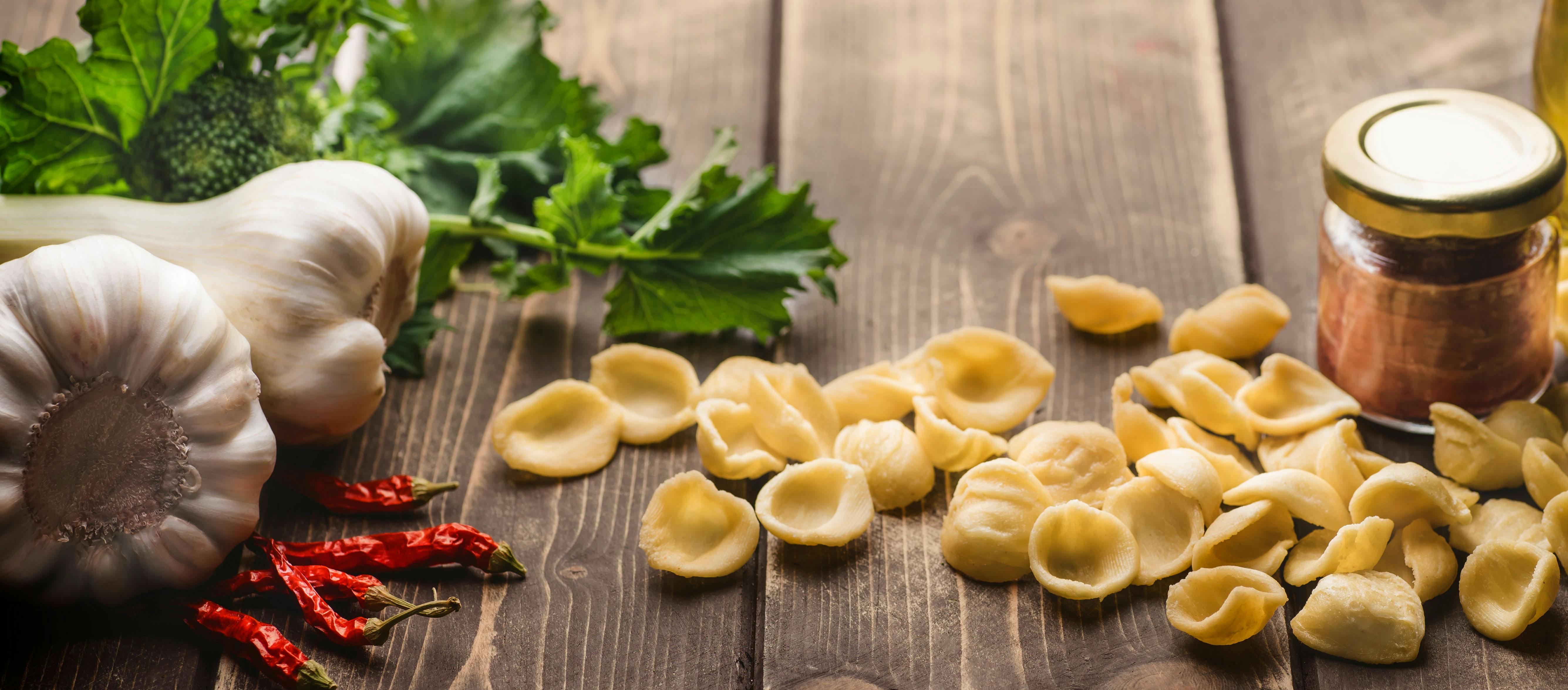S.A.L.T. Lab Lessons: One of the Best Things to Do in Puglia? Make Pasta
In this series of stories, we share some of the most popular recipes taught at S.A.L.T. Lab, inspired by our experiences in the Mediterranean. This essay highlights one of the best things to do in Puglia: getting up close with the local pasta.
As Italians, we know a thing or two about lunch boxes. We’ve even built dishes around them. Take the fagioli al fiasco (literally “beans in a flask”): For this traditional rustic Tuscan recipe, beans are slow-braised overnight in the fireplace in a terra cotta flask with water, olive oil, salt, garlic and herbs, using residual embers from the day’s cooking. The next morning, the flask is ready to be taken to the fields, the factory or the artisanal bottega.
Then there’s the tiella, a clay pot with a lid, which used to be wrapped in a cloth to keep the dish warm and the lid in place as it was transported by farmers and shepherds. Tiella was also the name of the dish cooked in it: This was typically a casserole, and the original recipe called for baked white rice and mussels.
Bringing S.A.L.T. to Puglia
At S.A.L.T. Lab, we’ve used the concept of a tiella to put a fresh spin on an all-too-popular Pugliese specialty: orecchiette con le cime di rapa (orecchiette with broccoli rabe). The dish has become so ubiquitous it’s hard to think of anything else when ordering at a local restaurant, but any true Pugliese will tell you there is so much more to taste.
When Adam Sachs, global director of the S.A.L.T. program, and I set out to select Italian recipes to teach at S.A.L.T. Lab — the on-board kitchen-laboratory that hosts destination-inspired cooking sessions — we knew we wanted to create a strong connection with our shore experiences. For our travel to Puglia, we turned to the Montaruli brothers, Francesco and Vincenzo, who came up with the recipe for the tiella of baked, cheesy orecchiette highlighted below.
The brothers, who own the restaurant Mezza Pagnotta and also maintain a residency at the gorgeous Villa Fenicia in Ruvo di Puglia, near Bari, are hosts of the S.A.L.T. Experience called “The Wild Side of Puglia.” On this adventure with the region’s legendary foragers, they take guests to forage and cook with them on the Altopiano delle Murge.
For this unique trip, best suited for guests who like to hike, one heads to a karkastic plain — barren and almost moon-like. The area is shaped like a rectangle and is located between the Tavoliere delle Puglie (“Italy’s barn,” sown with wheat and oat) and the picture-perfect Salento, a soul-stirring place.
That’s where, for centuries, locals have gone to pick wild vegetables. The Montarulis forage on the Murge with a local legend, an old man called Ciccillo, who sports a huge silver mustache and rides a Gilera motorcycle equipped with off-road wheels and a massive bunch of wild herbs and flowers strapped to the back.
The Montarulis specialize in smack-your-lips, veggie-centric Mediterranean cuisine, and much of the “new cucina Italiana” is going in this direction. Our guests love to hear about the new league of Italian chefs and how they’re rethinking our classics. At the beginning of our classes, I show them the book I published on the subject (The New Cucina Italiana, 2021, Rizzoli New York), since we keep a copy in the Lab. There’s even a chapter on the Montarulis. Then we get to work.

Taking a love of pasta to the next level
I have found, as we teach this recipe at S.A.L.T. Lab, that many of our guests know orecchiette (literally “tiny ears”, because of their shape), which are common in the south of Italy, particularly in Puglia. Some of them have even taken pasta classes and know how to make them from scratch.
What most people don’t know, however, is that there’s a substantial difference between fresh pasta made in the north of Italy and fresh pasta made in the center-south.
In the north, pasta for tagliatelle, tortellini, etc. calls for eggs and common wheat flour (the so-called “tipo 00”). There are a few exceptions to this: Passatelli, for instance, is a kind of fresh pasta that uses fewer eggs but incorporates Parmesan and bread crumbs. In the center and south, including Puglia, fresh pasta is just Durum wheat flour (semola) and water — nothing else.
With orecchiette, the dough is rolled, then cut in cubes. Those cubes are flattened and dragged out on the bench with the tip of the thumb and finally turned inside out.
Other popular formats in Puglia are troccoli (sort of a thicker tagliolini) and cavatelli (elongated gnocchi, folded in the middle). Some pastifici even make fogliette di ulivo (olive leaves) to honor the region’s most famous natural symbol. As we make this dish in the Lab, many point to the similarities with baked ziti. After all, they’re both types of pasta al forno and baked pasta au gratin — a versatile preparation.
While we clean, blanch and sauté the cime di rapa, we talk about the many ways this same concept — making pasta, adding a sauce, meat, vegetables, topping it with cheese and finishing it in the oven until crispy golden on top and gooey inside — can be applied to many recipes.

For the tiella below we use caciocavallo, a stretch-curd cheese made from either cow’s or sheep’s milk, very common in the center and south of Italy where it takes on different nuances, depending on which milk is used (in some cases, it has to come from a specific cow’s breed) and how it’s cooked and aged. If you can’t find it, you can substitute it with provolone (which belongs to the same family). Pro tip: Always remember to reserve some pasta water (which in this case is the same water the broccoli rabe is blanched in), since the starch released by the pasta during cooking will help you thicken any sauce. Enjoy!

TIELLA DI ORECCHIETTE AL FORNO
INGREDIENTS / Serves 4
2 pounds or 1 kilo turnip greens
14 ounces or 400 grams orecchiette pasta
3 garlic cloves, minced
1 chile, minced
7 ounces or 200 grams grated caciocavallo
Extra virgin olive oil to taste
PREPARATION
- Pre-heat the oven to 180C / 350F.
- Prepare the turnip greens by removing the stems. Keep all the young and tender floral shoots.
- Bring a pot with plenty of salted water to a boil. As soon as the water boils, add the turnip greens in it and let them cook just until soft.
- Remove them from the water and let them cool under cold water. Meanwhile, heat some olive oil in a pan, and sauté the garlic and chile. In the same cooking water add the orecchiette and let them cook for about 10 minutes. When ready, drain the pasta, and add it together with the turnip greens into the pan with the garlic and chile.
- Add the grated caciocavallo mixing well to incorporate all the ingredients.
- Transfer to a serving dish, lightly greased with extra virgin olive oil and sprinkle the surface with more grated caciocavallo.
- Bake in the oven for about 15 minutes.
Silversea’s S.A.L.T. — which stands for Sea and Land Taste — is an innovative program celebrating the culinary arts of our destinations, offered on Silver Moon, Silver Dawn and Silver Nova.
There are four pillars to S.A.L.T., and the first three are offered on board. S.A.L.T. Kitchen is a restaurant dedicated to showcasing food and wine from the region in which the ship is traveling; the regional menu offers changing options based on the port of the day. In S.A.L.T. Lab, guests enjoy the challenge of cooking regional dishes, and S.A.L.T. Bar offers cocktails made with local ingredients. The S.A.L.T. Experiences, meanwhile, move in the opposite direction. This exclusive-to-Silversea series of shore excursions, hand-curated by local experts in the worlds of cuisine and wine, offer personal connections to the places we visit.
Want to experience more of the local culture when you travel to Puglia? Check out these Silversea Mediterranean cruises, and see how one writer experienced the best things to do in Puglia during her travels.
